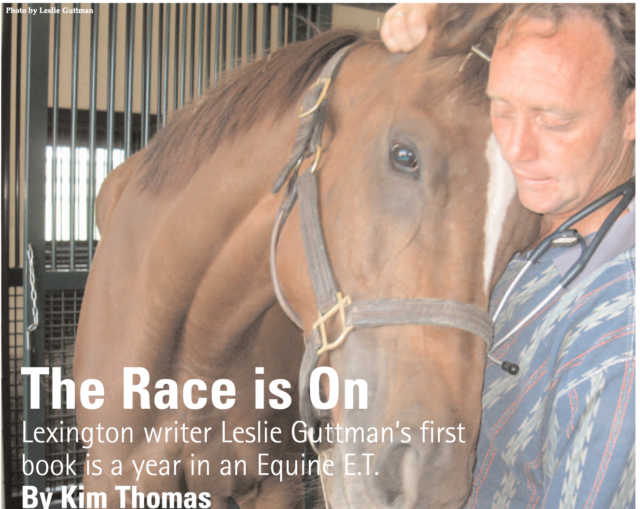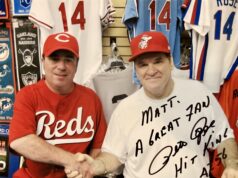10.21.2009 View PDF coverstory October 21, 2009 A Conversation with Equine ER author, Leslie Guttman
The Race is On
Lexington writer Leslie Guttman’s first book is a year in an Equine E.R.
By Kim Thomas
Reading Leslie Guttman’s book, Equine ER: Stories from a Year
in the Life of an Equine Veterinary Hospital is like watching ER on television back in the good ol’ days when George Clooney was still its star. You don’t want to know what happens if it’s not a success story, but you can’t turn away.
Guttman’s non-fiction work is a sensitive look at the daily operations of Rood & Riddle Animal Hospital. Rood & Riddle is located here in Lexington and is a premier veterinary facility for Thoroughbreds — or other horses — in medical distress. Horses’ natures are so delicate, it only takes one wrong turn of the foot or the digestive tract to create an equine emergency, and Guttman’s work highlights the veterinary treatment of these powerful but fragile animals whose owners make the Bluegrass their home.
“This book is about the year I spent starting in spring 2008
following around the veterinarians at Rood & Riddle, one of
the most prominent equine hospitals in the country. It is about these veterinarians’ world and the horse-smitten clients and four-footed patients within it. Hospitals are places where life turns on a dime, and this one is no different: I saw lives saved, lost, and remade. I also saw that alongside the advanced veterinary medicine being performed exists something timeless about the job of an equine veterinarian … found in experiences such as the small miracle of watching a foal … get up and walk for the first time, wobbly but persevering. Or in the ritual of an equine vet making a farm call in spring, his or her truck rattling up to an old black barn, past paddocks colored kelly green from the rain and dotted with mares and foals.”
Guttman was approached to write the book in January
of 2008. “I was here in Lexington visiting my mom from my home in the Bay Area when I connected with Eclipse Press/Blood-Horse in January 08. Equine ER was Eclipse Press’ idea. They wanted a book that would connect with not only horse people but a general audience. After they saw my newspaper and magazine work, they thought I’d be a good
fit, even though I’m not ‘horse person.’ Although I rode a bit growing up here, and have been on every trail ride from Half Moon Bay to Lake Tahoe, I have never owned a horse.” “Although my work has been diverse — writing stories on everything from at-risk kids to the environment — thematically, I’ve always been attracted to stories where there is something great at stake and where there is also a lot of emotion. A hospital is a setting where there is a great deal at stake, even a hospital for horses, which was part of the pull for me to write it.”
“I had written medical and science stories before, but nothing of this depth. The learning curve was steep for the medical reporting. The vets helped me by answering count- less questions. Every medical aspect of the book was triple- fact-checked: first by me, then the vet whom the chapter is about, and by another vet at R&R, Dr. Bryan Waldridge, who volunteered to help me out.”
When asked how she convinced Rood & Riddle to allow
her to observe their operations, Guttman acknowledges the
cooperative spirit she found. “The clinic was open to it as long as I just observed and didn’t touch anything sterile. After a while, I was at the clinic so much that I kind of became wallpaper for them; they got used to having me around, which was great, because then they didn’t edit what they said.” She admits, “Before I wrote the book, I had no idea how accident-prone and delicate all horses can be because of their susceptibility to paddock accidents — stepping in groundhog holes, running into fences, etc — and because of the mobility of their digestive tracts, which predisposes them to colic.”
“As far as feet/ankles/legs, if you’re talking solely
about Thoroughbreds and racing, that brings in the whole debate about whether today’s breeding practices are creating
horses that are more fragile than those that raced 20 or 30
years ago. I talk about this at length in the last chapter in the aftermath of Eight Belles’ death. I don’t feel like I know enough about breeding myself to make a definitive judgment, but many horse people believe both what’s known as breeding for speed and breeding for horses that look good in the sales ring have made for a more fragile racehorse. However, they also add that other factors are equally important, such as how owners and trainers individually treat their horses. Unfortunately, no data exists to compare the break- down rate between today’s horses and those of the past.”
“Many of the stories in Equine ER are about horses other than Thoroughbred racehorses. But because this is the Bluegrass, they are well represented. With all the risk involved in being in the Thoroughbred industry, what I came away with is that no matter how much of a business it is, in the end, it is run by dreamers who can’t do anything else, even if they’ve tried. In that way, it’s like being a writer.”
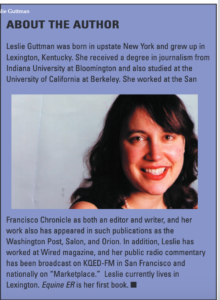 Guttman was inspired by the lessons learned in her year
Guttman was inspired by the lessons learned in her year
spent observing life in a veterinary hospital. “What surprised and moved me about being at the clinic was learning and seeing that a horse’s desire to live is just as important as it is with a human patient suffering from a major illness or severe trauma. Like at the track, the odds don’t determine the outcome. Definitely some life lessons there. Equine ER is for horse lovers, animal lovers, people
who love hospital dramas, and anyone intrigued and interested in the bond between people and animals.” In addition, she wanted to give readers an inside look “at this unique pack of passionately committed workaholic equine
vets who are also very funny. The place reminds me of TV
shows like Grey’s Anatomy, House, or Scrubs, but with horses.
And you just can’t believe how hard these vets work and how
high their standards are. I found it consistently inspiring. They treat 11,000 horses a year in the clinic, another 5,000 out in the field, and in 2008 performed approximately 6,500 surgeries.”
“One way I describe the book is Animal Planet meets James Herriot. Over and over throughout the year I met people — interns, vets, clients, and owners — who were keenly influenced as young people by the James Herriot books. Many
of them became veterinarians or got into the horse world
because of them. One of my intentions with Equine ER is that
it be inspiring in the same way … and that it is also a postcard from the Bluegrass in the same way Herriot’s books are postcards from the English countryside, describing the landscape,people, and unique farm way of life. I wanted people who didn’t live in the Bluegrass to smell of the air, see the miles of kelly green paddocks, and meet people whose lives are still defined by the seasons. Even with all its stresses, it is a more peaceful life than the technology-driven one so many of us live.”
Guttman breaks out of the starting gate with a vivid
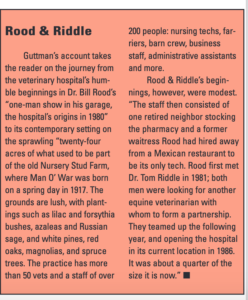 prologue recounting the unforgettable history of the
prologue recounting the unforgettable history of the
2008 Derby, when Big Brown made his move in the middle of the pack to win, and the filly Eight Belles, finished second. Guttman describes the heartbreak as news came to the Rood & Riddle facility that Eight Belles had broken both of her front ankles, and the decisions that had to be made
within seconds to euthanize her. Guttman was at the vet hospital on Derby day, a day she appropriately describes: “For horse people everywhere, but especially in the Bluegrass, Derby Day is a religious holiday. Thousands of people were preparing to watch the race at Churchill Downs or on TV, and between taking care of patients, some Rood & Riddle staff members would be able to catch the race in the admissions office. Although they didn’t know it yet, those staff members would see the death of Eight Belles, the charcoal gray filly who would break down after finishing second and be euthanized immediately because of the depth of her injuries. Her shocking death on national television would bring significant changes to the racing world, with equine vets such as Rood & Riddle’s Dr. Larry Bramage playing key roles in the debate and discussion the filly’s death ignited.”
Eight Belles was the first Thoroughbred to die in 134 years of the Kentucky Derby, and although her tragic story reverberated in the hearts of horse lovers everywhere, the event caused the industry to reconsider some options and changes were and are being made to make tracks and racing safer for these sturdy but delicate athletes.
Guttman has changed the names in some cases of the owners and horses to respect the wishes of those who wish to remain anonymous. The chapters give a peek into the very human side of the vets who provide care. The book is certain to be scooped up as the horse world readies itself for the Breeders’ Cup and next year’s road to the Derby, which of course, will be followed by the World Equestrian Games presented by Alltech here in the heart of our gorgeous home with the rolling hills and grass so filled with limestone, it’s called the Bluegrass. As we prepare for the visitors that will certainly be watching the WEG activities, Guttman’s nonfiction work is a must-read for those who want to know what goes on behind the scenes before and after the best of the best equine athletes perform for the world.
This story is a cover story in the print edition of the October 22, 2009 with Videos from the Equine E.R. YouTube series.
Kim Thomas is a former writer for The Thoroughbred Record and writes about Thoroughbred racing in her blog.
EXCERPT FROM EQUINE E.R.
Worries
Dr. Tom Riddle’s up at 4am in foaling season
By Leslie Guttman
Excerpted from Chapter 14 of Equine ER (Eclipse Press, 2009), entitled “Worries,” about Dr. Tom Riddle, co- founder of Lexington’s Rood & Riddle Equine Hospital
Even with Dr. Tom Riddle’s love for the work and his financial success, it is a demanding life. From January through June when it is Thoroughbred foaling and breeding sea- son, Riddle is up at 4am seven days a week, asleep by 9pm. He hates the cold, and the barns are miserably damp and freezing in winter. Although Riddle is home in time for dinner almost every night, it is not a job that you ever turn off.
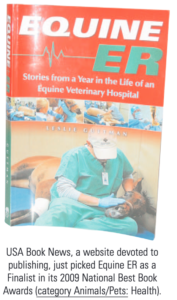 The other day, while cleaning out his desk at home, he found an old ultrasound picture he’d saved. He was excited, thinking it was a picture of one of his three grown kids. It was of Winning Colors, one of the three fillies that have won the Kentucky Derby. (Winning Colors was also the horse who gave Riddle the worst kick of his life, catching the back of his thigh during a rectal palpation. She didn’t break the leg, but the pain and the bruises stayed for weeks. The roan mare died in
The other day, while cleaning out his desk at home, he found an old ultrasound picture he’d saved. He was excited, thinking it was a picture of one of his three grown kids. It was of Winning Colors, one of the three fillies that have won the Kentucky Derby. (Winning Colors was also the horse who gave Riddle the worst kick of his life, catching the back of his thigh during a rectal palpation. She didn’t break the leg, but the pain and the bruises stayed for weeks. The roan mare died in
2008 at twenty-three.)
But when I accompanied Riddle on a farm call one summer day, I realized the draw of being an equine veterinarian, at least one in the field, no matter how consuming the job or how ever-present the possibility of getting kicked. It was late August; the weather was clear, no humidity, a flirty breeze. As we drove, miles of blue sky and green pas-
tures unfurled before us. The landscape made me remember what an acquaintance’s niece, coming to Lexington for the first time, said when she looked out the window of her plane as it descended: “I’ve never seen so many shades of green.” As we turned into the driveway, Riddle said, “These are the kind of farms that remind me of my dad.”
(Riddle’s father is also a veterinarian.) It was a small spread. The barn was black with white trim, and worn bridles hung from a row of hooks next to the stalls. A handful of horses lived there. The family was excited to hear the foal was going to be a colt. The only other sounds were birdsongs and the shifting
of residents in their stalls. Away from texting, computers and cell phones, and the news of a troubled economy, Riddle’s job felt like that of an old-fashioned country vet in another era. Having just left a big city, I also thought on that day, and on others after it with different vets, about how calm- ing it is to be around horses and other animals, how peaceful they can be and how uncomplicated. Most horses are patient. Most people are not. For college students trying to decide whether to go into human medicine or veterinary, those facts can contribute to making a choice for the latter. Then of course, there’s always one of the big reasons Dr. Katie Garrett, another Rood & Riddle vet, told me why people choose to become doctors of equines rather than of humans, “Patients look a lot better
with their clothes off.”
Lexington writer Leslie Guttman will sign Equine ER: Stories from a Year in the Life of an Equine Veterinary Hospital at Keeneland Gift Shop Sunday, October 25, 11 am to 1pm. Guttman will also be signing copies at the Ace Gallery Hop stop at Woodland Computers, on Friday, November 20, 2009, 5pm to 7pm.


